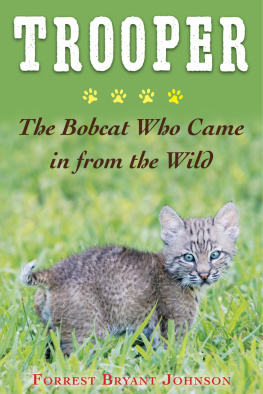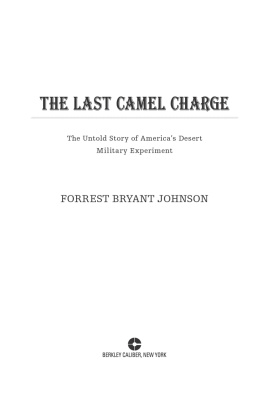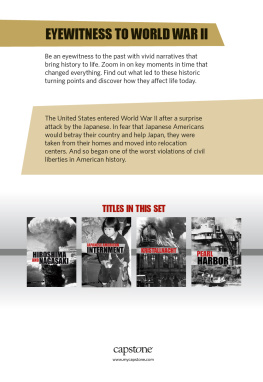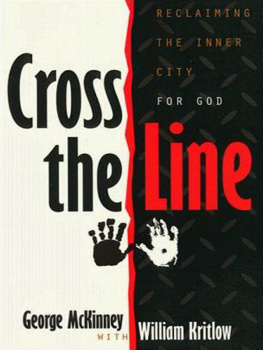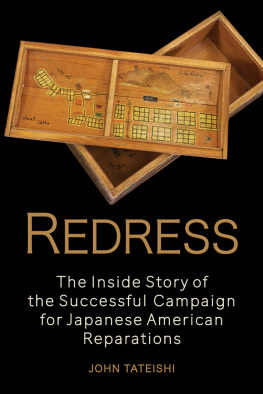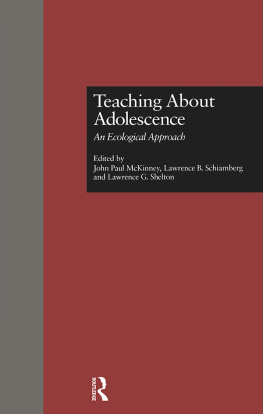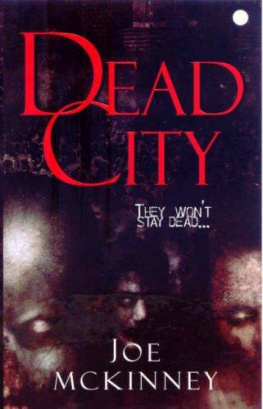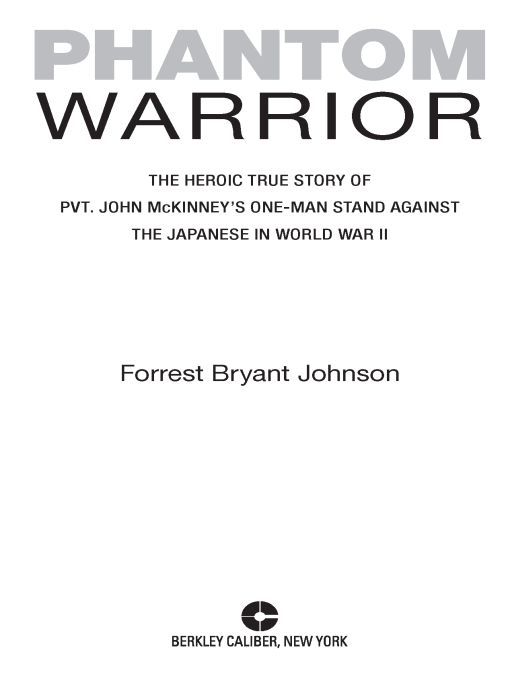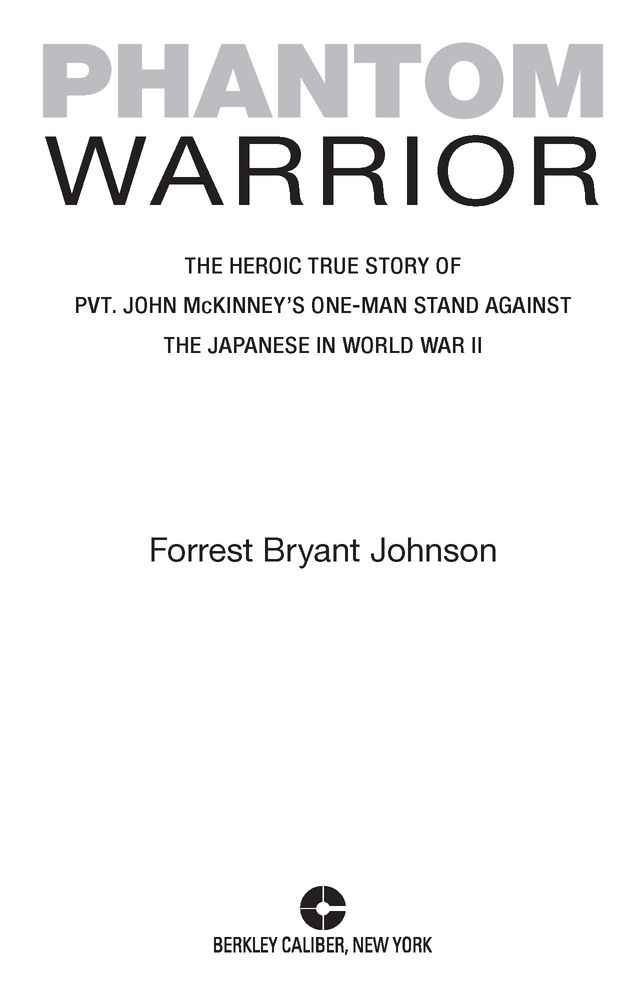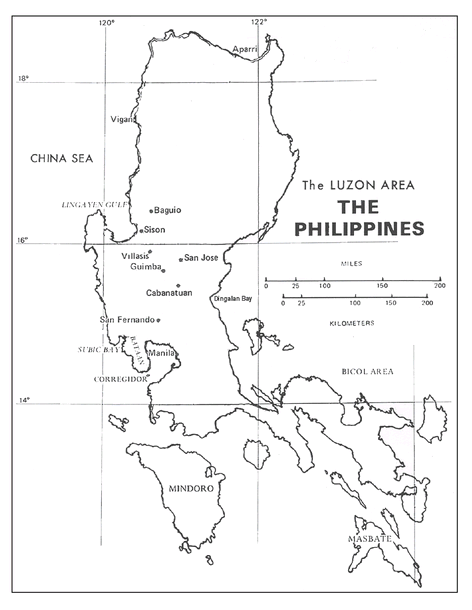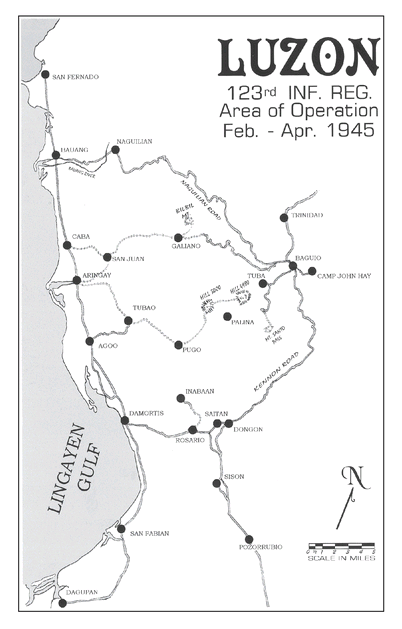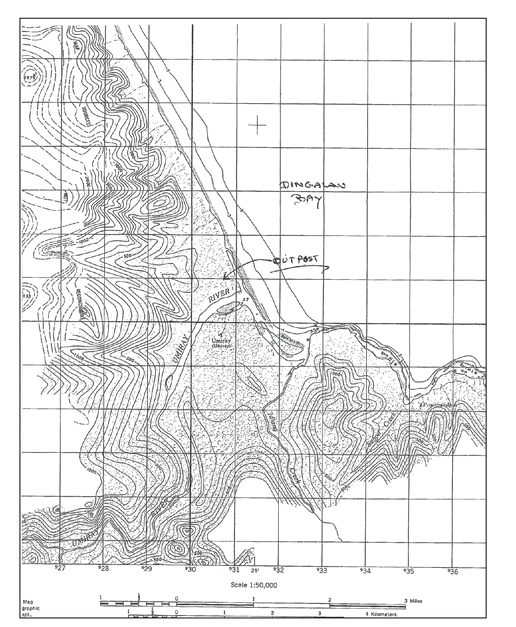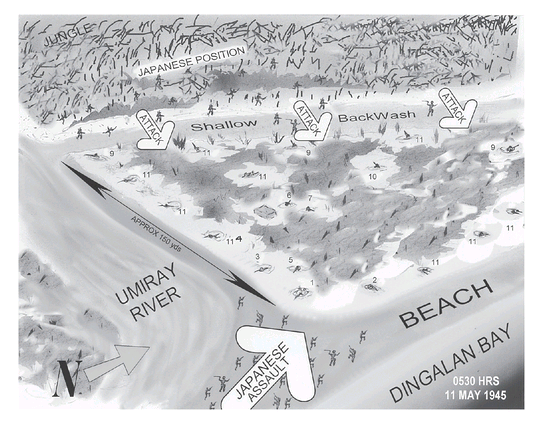Table of Contents
Most Berkley Caliber Books are available at special quantity discounts for bulk purchases for sales promotions, premiums, fund-raising, or educational use. Special books, or book excerpts, can also be created to fit specific needs.
For details, write: Special Markets, The Berkley Publishing Group, 375 Hudson Street, New York, New York 10014.
Other Books by Forrest Bryant Johnson
WHAT ARE YOU DOING DERBY DAY?
THE STRANGE CASE OF BIG HARRY
BASENJIDOG FROM THE PAST
RAID ON CABANATUAN
HOUR OF REDEMPTION
TEKTITE
To that generation of Americans who sacrificed during those
dark days of World War II
Copy of the map issued to the Connolly Task Force in May 1945. The outpost location, junction of the Umiray River and Dingalan Bay. Officially titled by the Army Map Service, Umiray, Talabas Province, Luzon, 1:50,000. 1944
The National Archives
APPROXIMATE POSITIONS AT THE UMIRAY OUTPOSTMOMENTS BEFORE THE JAPANESE ATTACK.
1. Light machine gun, .30 caliber, manned by PFC Morris Roberts and PFC Eldon Homan and Filipino guerrillas.
2. Roberts and Homans foxhole, empty at 0530.
3. PFC Edward Colwell.
4. PFC Adolph Red Barrette.
5. PFC John McKinney and two Filipino guerrillas.
6. Lt. Max Ladin.
7. Tech. Sgt. Victor J. Wendling.
8. Command and supply tent.
9. Light machine guns.
10. Lt. Edwin Voss.
11. Rifleman with M1s and BARs supported by Filipino guerrillas. Inside the garrison, clumps of hyacinth appear as tree tops on aerial photos.
INTRODUCTION
So near is grandeur to our dust,
So near is God to man,
When duty whispers low,
Thou must, the youth replies, I can!
Ralph Waldo Emerson
On January 23, 1946, almost six months after the end of World War II, twenty-four-year-old Sergeant John R. McKinney, a Georgia farm boy, was ordered to Washington, D.C., and stood at attention in the Oval Office in the White House.
Behind Sergeant McKinney were his family and representatives from the news media. Officers from various branches of the military quietly joined the ceremony. Two older men, also in uniform, moved in front of the others. Everyone recognized General Dwight D. Eisenhower and Admiral Chester W. Nimitz. Soft whispers floated briefly about the room.
Then silence. Harry S Truman, president of the United States of America, had entered.
Someone with a loud clear voice read an official proclamation, the citation explaining just why Sergeant McKinney, the son of a sharecropper with only a third-grade education, was invited to the White House.
The reader quoted inspirational phrases from the citation that could bring goose bumps to a patriotic AmericanHe fought with extreme gallantry to defend the outpost, alone with only his rifle to meet the advancing Japanese. By his indomitable spirit, extraordinary fighting ability, and unwavering courage in the face of tremendous odds, he saved his company from possible annihilation.
The president placed a blue ribbon over Sergeant John McKinneys head. From it dangled our nations highest award for gallantry, the Congressional Medal of Honor.
There can be no greater honor in the world, President Truman said in his short speech.
I first heard of John McKinneys deeds on Luzon in the late 1970s while gathering information for my book Hour of Redemption. Actually, I did not have McKinneys name then, only reports from Filipino war veterans in Cabanatuan City. They spoke of a GI rifleman who, at a place called Dingalan Bay, made an incredible one-man stand against attacking Japanese soldiers.
The Philippines suffered greatly during World War II. On my journeys in Luzon, I dont think I met a single individual who had not lost a loved one in that war. Tales of bravery, many exaggerated, were related as if they happened only yesterday and had already become legend.
My escort at Cabanatuan consisted of an interpreter, a driver/guide, and a few fellows who insisted on going along as bodyguards. We piled into a jeep, a relic of World War II, and headed into the Sierra Madre Mountains in search of Captain Juan Pajotas World War II guerrilla camp. Pajota was the hero of the battle at Cabu Bridge, where his forces held a Japanese battalion while American Rangers and Alamo Scouts liberated Allied POWs interned at Camp Cabanatuan. Often during the war, Pajota and his men eluded the Japanese by escaping into the Sierra Madres.
Armed with a good map provided by Pajota, we easily located the remains of his camp. As usual in the tropics, trees and thick brush had taken control of the area since 1945.
At the insistence of my guide, we continued up the mountain on a dirt road, the engine of the old jeep chugging and coughing as it struggled with its weight to reach a vista near the top.
There we commanded a breathtaking view of Dingalan Bay.
My guide pointed at a barren beach where a muddy river perhaps three hundred yards wide flowed into the bay.
That is the place, sir, my guide stated. There is where our people say a lone GI killed many Japanese! I had journeyed to Luzon for the purpose of researching the story of the POW camp rescue. Though it was tempting, I could not permit myself to become involved in another project.
But something bothered me about that beach. It haunted me for twenty-five years, until I decided to solve the mystery of what really happened there. I remember it as a small, dark sandy area the size of two football fields with Dingalan Bay on the east, a river to its south, and dense jungle bordering the north and west. Why were American soldiers fighting in such a strange place? It seemed to have no apparent strategic importance.
In the Philippines during World War II, as in other parts of the world, thousands of Americans performed with extraordinary bravery. The veterans of that war are passing away in large numbers each day and the memories of what they accomplished are fading. Few will ever read of their individual battle experiences.
The story of a battle is more than plans made by high command or orders issued in the field as the fight begins. Battle is composed of individual sagas of men who may have once had high ideals, like love of family and country. Combat reduces all of that to one instinctdestroy and survive.
Combat is a personal thing for each warrior as his world is suddenly reduced to the small piece of land on which he must stand and fight.


